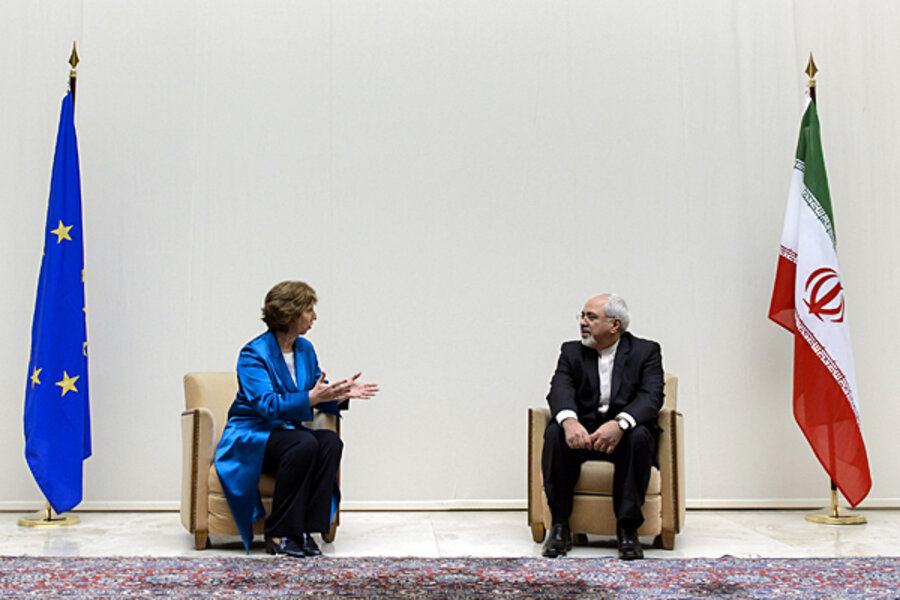Iran nuclear talks: No news may be good news on Day 1
Loading...
| Geneva
Iran and six world powers capped a day of apparent progress at nuclear talks in Geneva with a rare, hour-long bilateral meeting between senior American and Iranian negotiators.
US Deputy Undersecretary of State Wendy Sherman met with Iranian Deputy Foreign Minister Abbas Araghchi at the end of a day of diplomacy, during which Iran laid out a new road map to limit its nuclear program in exchange for easing crippling sanctions.
The meeting tonight – and the fact that neither the Americans, Europeans or Iranians gave off-the-record briefings but only issued short statements, at most – indicates that progress and possibly compromise is under discussion.
“The discussion was useful, and we look forward to continuing our discussions in tomorrow’s meetings,” said a senior US State Department official about the third high-level US contact in a single month. The first direct contact between US and Iranian presidents in a generation happened via a phone call at the end of September.
The meeting “demonstrates our continued commitment to bilateral engagement,” said the US official, in the context of nuclear talks with six world powers.
Iran has invigorated its diplomatic outreach since the June election of President Hassan Rouhani, a centrist cleric who says he wants to resolve Iran’s decade-long nuclear controversy with the West in three to six months.
The new Iranian proposal – presented via PowerPoint this morning in the first session of two-day talks by Iranian Foreign Minister Mohammad Javad Zarif – was followed up by expert-level technical discussions in the afternoon.
“For the first time, very detailed technical discussions took place,” said Michael Mann, the spokesman for EU foreign policy chief Catherine Ashton, who is leading the talks for the P5+1 group (the US, Russia, China, Britain, France and Germany).
That exact choice of words was echoed by a senior US official, who said in a statement: "For the first time, we had very detailed technical discussions."
Mr. Mann said the Iranian proposal was “very useful," but there’s still a lot of work that needs to be done. He said Iran had spelled out “what they envision” as the endgame, and that negotiators would “get into the nitty-gritty” tomorrow.
Iran called its presentation “Closing unnecessary crisis, and opening new horizons,” an allusion to its effort to harness the political changes currently underway in Tehran, where the rise of a centrist president is being used to recalibrate an unsuccessful foreign policy under arch-conservative President Mahmoud Ahmadinejad.
Mr. Araghchi said earlier in the day that the details of Iran’s proposal would remain secret until a deal was struck.
“Our objective is to guarantee our country’s right to peaceful use of nuclear activities, including [uranium] enrichment, and to ensure that the nature of these activities is peaceful,” said Araghchi in Persian.
Both Iran and the P5+1 see this round of talks in Geneva as an opportunity to move forward after 18 months of an often-frustrating negotiating process.
Iran has long signaled that it was willing to halt its most sensitive nuclear work – enrichment of uranium to 20 percent purity, which is a few technical steps from bomb-grade – and agree to more intrusive inspections measures. But the sanctions relief offered in exchange was never enough for Tehran.
The P5+1 likewise never clarified for Iran that future enrichment would be permitted inside Iran, even for the peaceful purpose of power production and medical isotopes that Iran declares to be its aim.
The US-Iran bilateral meeting today between Ms. Sherman and Araghchi is the latest high-level contact between the two arch enemies in the past month. Mr. Zarif met for 30 minutes with US Secretary of State John Kerry in New York on the sidelines of the United Nations General Assembly in late September.
Just two days later, President Barack Obama shared a historic 15-minute phone call with Mr. Rouhani as the Iranian president headed to the airport to depart New York. It was the highest-level contact between the two countries since Iran’s 1979 Islamic revolution ushered in decades of mutual hostility.
The Iranian and American camps are both facing criticism back home from conservatives who object to any nuclear deal or any contact with the other side.








